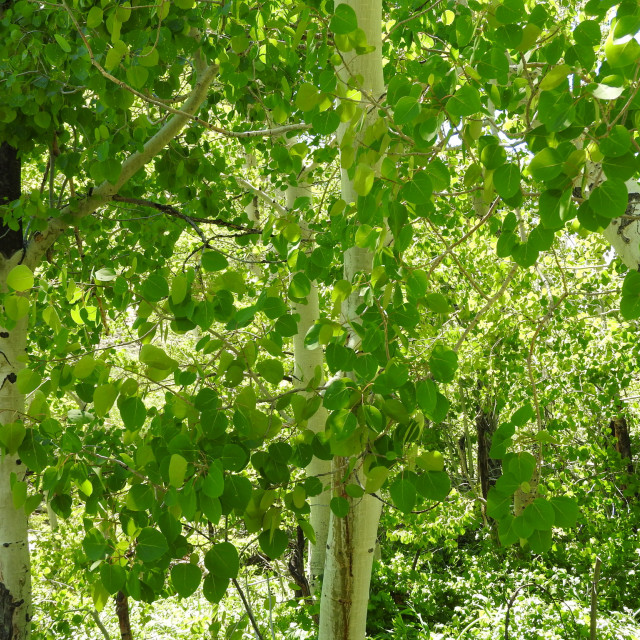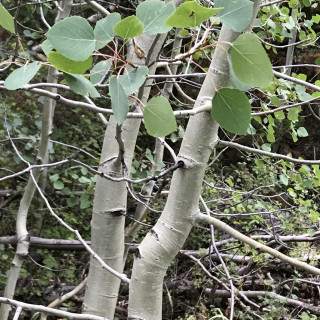COMMON NAME
trembling aspen
SCIENTIFIC NAME
Populus tremuloides
ALSO KNOWN AS
quaking aspen
Plant family
Willow (Salicaceae)
Plant group
Deciduous Trees and Shrubs
Trembling aspen is a small to medium-sized perennial woody tree native to much of North America.
1309 reports
343+
OBSERVERS
1309+
OBSERVATIONS
Identification hints
Quaking aspen is unique in its smooth rounded leaves which flitter in the slightest breeze, due to the thin flattened stems (petioles) and its bright white or cream colored bark. In the Midwest and northeastern US you can also see bigtooth aspen (Populus grandidentata) which has coarse rounded teeth on the leaf margin, fine hairs on stout twigs, dusty gray buds and brown or green bark. White poplar (Populus alba) is an introduced tree from Europe that is also similar to quaking aspen but has coarsely toothed leaves that are noticeably dark green above and silvery-white beneath. Poplars and cottonwoods generally have triangular-shaped leaves.
Did you know?
Trembling aspen is widely distributed the most common Populus species of North America. What looks like an individual tree is usually one stem of an extensive clone with many stems/trees that are connected underground by one root system. Entire clones are either male or female, making trembling aspen a monoecious species. One male clone in the Wasatch Mountains of Utah occupies 108 acres and is considered the largest and heaviest organism in the world! It is thought to be several thousands of years old. Although individual ramets /trees of a clone may be short-lived, the clone may be long-lived.
DISTRIBUTION IN TH U.S.
Alaska
,
Arkansas
,
Arizona
,
California
,
Colorado
,
Connecticut
,
Delaware
,
Iowa
,
Idaho
,
Illinois
,
Indiana
,
Kentucky
,
Massachusetts
,
Maryland
,
Maine
,
Michigan
,
Minnesota
,
Missouri
,
Montana
,
North Carolina
,
North Dakota
,
Nebraska
,
New Hampshire
,
New Jersey
,
New Mexico
,
Nevada
,
New York
,
Ohio
,
Oregon
,
Pennsylvania
,
Rhode Island
,
South Dakota
,
Texas
,
Utah
,
Virginia
,
Vermont
,
Washington
,
Wisconsin
,
West Virginia
,
Wyoming
HABITAT
Trembling aspen occurs in a variety of habitats and a great range of elevations. It characteristically forms pure or mixed stands with Bigtooth aspen in eastern North America, and with Balsam poplar or Narrowleaf cottonwood in the west. It is common in dry and moist woods, but cannot tolerate shade. Trembling aspen occurs along stream sides, slopes near valley bottoms, dry mountainsides, high plateaus and mesas, talus, openings and slopes in montane and subalpine forests and woodlands. It is a pioneer in disturbed sites with bare soil.
ATTRIBUTES
Leaves
Leaves of trembling aspen are simple, deciduous, broadly oval-shaped to nearly round, coming to a pointed tip long with small, rounded teeth on the leaf edges. They have a slender, flattened leaf stem (petiole) which allows the leaves to flutter in the wind. Mature leaves are darker green and waxy above, pale green or gray below, turning yellow, orange, gold, or reddish in the fall.
Flowers
Male and female flowers are found on different plants. Each flower is borne in pendent silvery-green catkins (they resemble soft caterpillars hanging from twigs). Flowering requires sustained air temperatures above 54°F for about 6 days. Female trees generally flower and leaf out before male trees.
Fruits
Trembling aspen fruits are borne on female trees and are green, round and conical capsules arranged in hanging catkins. One single female catkin has between 70 and 100 capsules each with 6-8 seeds. When mature, the capsules split into two halves releasing the seed. Seeds are surrounded by tufts of long, white, silky hairs making the dispersing seeds look cotton-like. Water and wind disperse the seeds.
Bark
The bark of trembling aspen is typically smooth, greenish-white to gray-white, and thin and peeling when young. As the plant ages, the bark becomes thicker and furrowed, especially toward the base of the tree. Large trees can have black cracks near the base.
Bloom Time
Trembling aspen typically blooms in April and May.
See Menu
- 2021 Chicago Botanic Garden. All Rights Reserved.
-
Creative Commons
BY-NC-SA 4.0 - Terms of Use
- Privacy Policy
- Data Sharing and Citation Policies
- 2021 Chicago Botanic Garden. All Rights Reserved.




